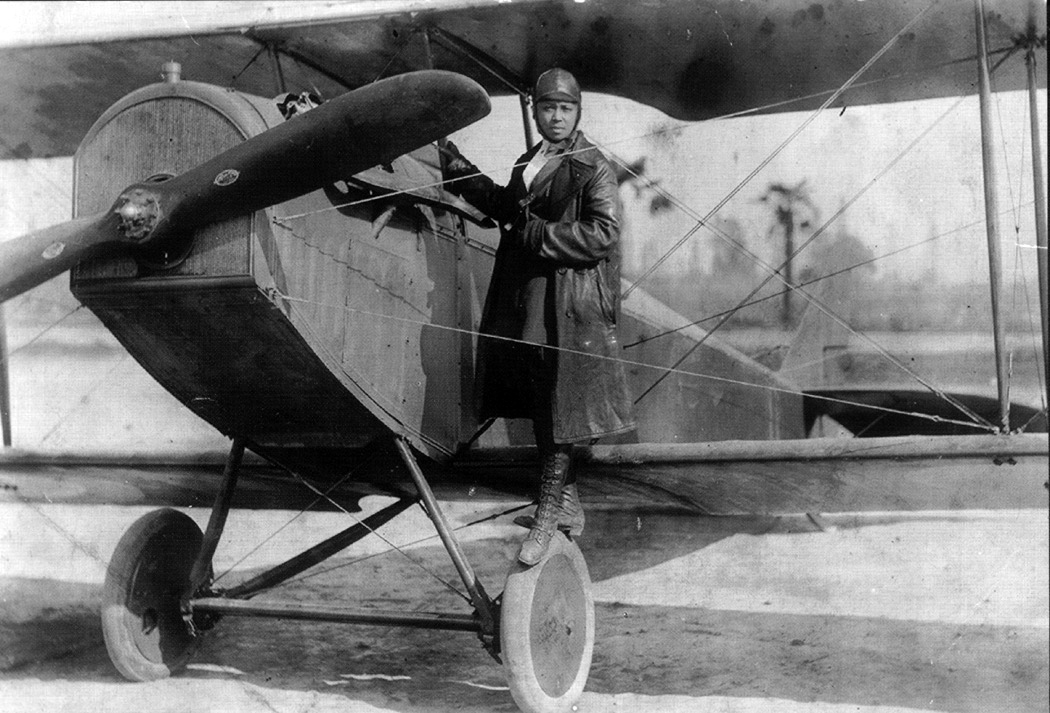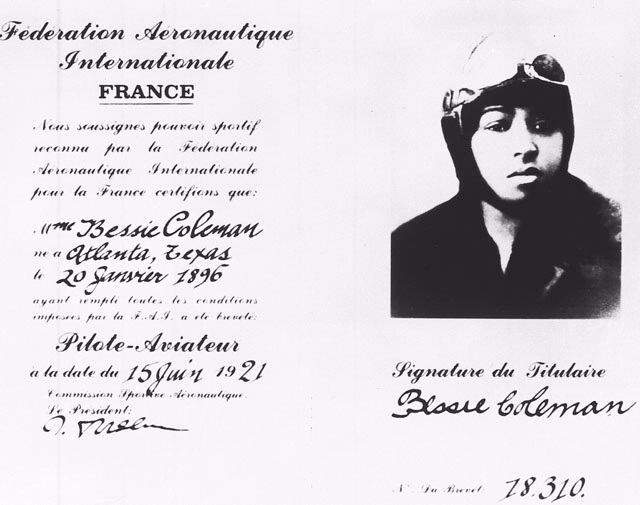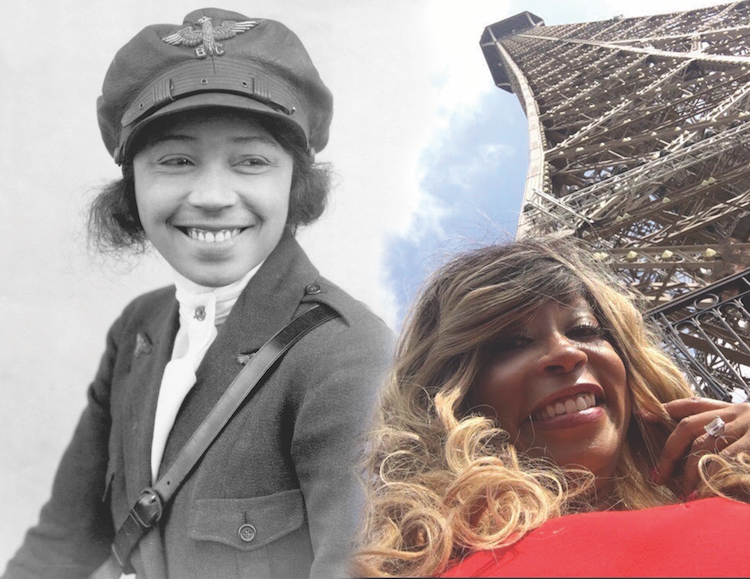Feature by Rita Kurtz
The Picture I’ll Carry When I Fly My First Plane

Dear Queen Bess:
I CHOOSE YOU. I choose you because you were not afraid to soar. Great things happened the year you were born. In 1892, Ellis Island began receiving immigrants, women were finally allowed to attend graduate school at Yale, and Vogue magazine was founded.
You were ahead of your time, Bessie Coleman. Ahem. Excuse me—aviatrix Bessie Coleman. American pilot schools couldn’t handle your mocha-brown skin and wavy natural curls. You were of African-American and Native-American descent. I am of African-American and European descent, but I see me when I look at you. Your 128th birthday was this past January 26, 2020, and I refuse to forget this precious date—the day fearless was born.
Bronze-skinned, multicultural beauties around the world still dream about becoming a pilot. But society still builds a massive blockade of rejection, doubt, and fear—much like the huge walls encircling a fifteenth-century castle built by my European ancestors—to prohibit us from flying. However, for you, that wall wasn’t big enough to block the sky.
I CAN ONLY IMAGINE the hell you went through—rejection after rejection. When you knocked on American flight school doors, I'm sure they were slammed past you like out-of-control revolving hotel doors in Chicago. When you walked in with confidence to see what needed to be done to succeed as a pilot, I’m certain the paleface men laughed and showed you the maid’s entrance instead of the door to opportunity.
You had to learn French and travel to France just to learn how to fly. To pass your pilot test, you soared over many places there, and I picture you flying over the Eiffel Tower, that beautiful, 1,063-foot intricately woven steel-laced monument—a great place to begin your journey.
On June 15, 1921, you received your Fédération Aéronautique Internationale pilot’s license. Eventually, you became an aerobatic pilot in the United States, mastering finely polished figure eights and trick climbing maneuvers. Nothing stopped your strong drive, incomparable tenacity, and unwavering dedication to flight. The year before you died, you had a flight exhibition in Houston on Juneteenth—June 19, 1925—a day that commemorates when African Americans in Texas finally learned the Emancipation Proclamation had abolished slavery.
When I visited the Eiffel Tower in the summer of 2016, I couldn’t fathom how you flew your Nieuport Type 82 biplane over something that tall. You described your aircraft as a “steering system that consisted of a vertical stick the thickness of a baseball bat in front of the pilot and a rudder bar under the pilot’s feet,” according to a story on the U.S. Air Force website.
At the base of the tower, I looked up and felt dizzy, admiring its wrought-iron latticed glory, imagining you in the air, in the sky, high above. I doubt you realized you were flying over what would become one of the most-visited monuments in the world a hundred years later. As you soared, you were free—at least until you landed.
I am sure you couldn’t understand why they said you were different. Your passion and zeal were no different from theirs when it came to flight.
I am positive they insulted you, called you the N-word to your face, told you “a woman cannot fly.”
I am grateful you committed yourself to encouraging aviation endeavors for future men and women of our race. In 1922, you told the Chicago Defender newspaper:
I thought it was my duty to risk my life to learn aviation and to encourage flying among men and women of our race who are so far behind the white race in this modern study. I made up my mind to try. I tried and was successful.
For this, I thank you.

QUEEN BESS, I WISH WE DID NOT SEE RACE, but instead just the human race. I wish we didn’t have to struggle and fight for equality in aviation as women—especially women of color. Why can’t we just enjoy flight? The sky does not see race. It doesn’t judge the person behind the control wheel and panel who's operating an aircraft.
Your thoughts about flight resonate: “The air is the only place free from prejudice.” I agree wholeheartedly. Furthermore, I’m sorry. I am sorry to report that racism and oppression still exist all these years later.
Queen Bess, I have to tell you, the airline industry has not caught up to your grace. As of 2019, by the Federal Aviation Administration’s count, less than 1 percent of major airline female pilots in the United States are African American; women of all races currently make up only 7 percent of US pilots. At times, I feel we’ve failed you. You worked so hard to break barriers, and we still aren’t changing the demographics.
I HAD PLANS TO DO MY OWN INTRODUCTORY FLIGHT in April 2020, but they were halted. No worries, Queen Bess—this time, it’s not because of the white man; the coronavirus pandemic got in the way. As soon as I can, I'll soar over Malibu, California, in a SportCruiser, a low-wing, two-seater modern aircraft. I'll carry a photo of you on that flight, just as the first African-American astronaut, Mae Jemison, did on her first mission to space. I may not be able to perform your loop maneuvers yet, but I'll be one more African-American pilot helping to close the discrimination gap.
Queen Bess, I hope all is not lost in aviation. I hope that social media, educators, parents, and other pilots will tell their little girls they can be pilots, too. You were not born to be the first African-American female pilot, Bessie Coleman—God had a much greater purpose for your existence. You were born to change the world.
With love, respect, and admiration,
Rita

Publishing Information
- “Bessie Coleman Biography (1892–1926),” Biography, A&E Television Networks.
- “Yesterday, Today, and Tomorrow” (biography of Bessie Coleman), compiled by Thelma Rudd on the Official Website of Bessie Coleman.
- “Bessie Coleman (1892–1926)” by Kerri Lee Alexander, National Women’s History Museum website.
- “Bessie Coleman: Woman Who ‘Dared to Dream’ Made Aviation History,” U.S. Air Force website, January 31, 2012.
- “In Figures,” Eiffel Tower website.
- Queen Bess: Daredevil Aviator by Doris L. Rich (Smithsonian Books, 1993).
- “Where Are All the Black Women in the Flight Deck?” by Jennifer Zabasajja, Bloomberg, October 15, 2019.
- “Young Girl’s Curiosity of Science Leads to Becoming First African-American Woman in Space,” U.S. Air Force website, February 12, 2012.
Art Information
- “Bessie Coleman” and “Bessie Coleman License” © Smithsonian Institution; fair use.
- “Queen Bess (circa 1922) and Rita at the Eiffel Tower (circa 2016),” compiled from images of Bessie Coleman (public domain) and Rita Kurtz (used with permission).
 Rita Kurtz of Beverly Hills, California, is an entertainer and a recently published nonfiction writer. She divides her time between performing on television, radio, and stage. Her appearances air on Lifetime, History Channel, and the Paramount Network. As a prior executive producer and host, her shows were broadcast on Warner Brothers Television and Fox. She has headlined with a musical company and performed the national anthem for several professional sports teams around the country. She is most recognized for the TV commercial in which she belted opera on a bus with a guy dressed like a viking.
Rita Kurtz of Beverly Hills, California, is an entertainer and a recently published nonfiction writer. She divides her time between performing on television, radio, and stage. Her appearances air on Lifetime, History Channel, and the Paramount Network. As a prior executive producer and host, her shows were broadcast on Warner Brothers Television and Fox. She has headlined with a musical company and performed the national anthem for several professional sports teams around the country. She is most recognized for the TV commercial in which she belted opera on a bus with a guy dressed like a viking.
She is currently a journalism graduate student at Harvard University.
For more information, see Rita Kurtz’s website or follow her on Twitter @RitaKurtz or Instagram @iamritaritarita.
